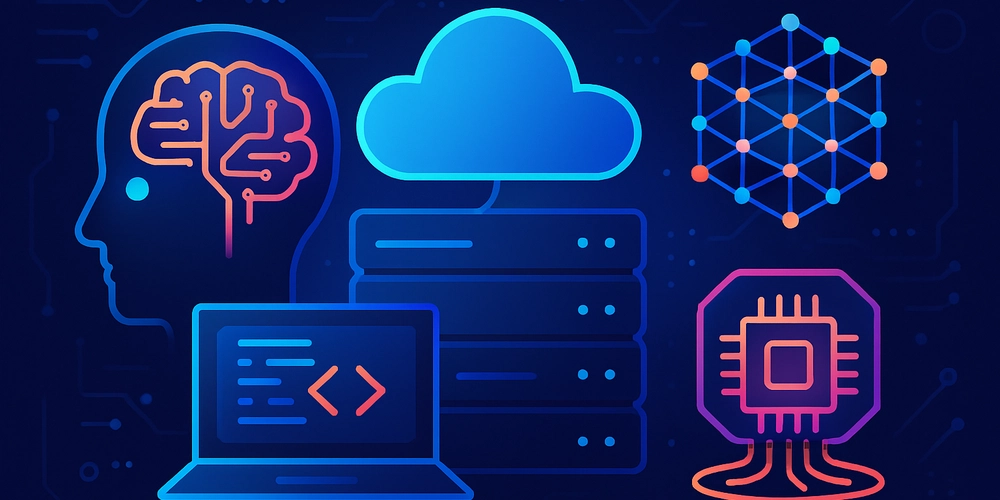Weekly Insights: AI, Cloud, and Quantum Advances (May 4–16, 2025)
In the past two weeks (May 4–16, 2025), the tech world saw a flurry of cutting-edge announcements across artificial intelligence, cloud computing, and quantum technology. Major industry players and research institutions unveiled new AI models and tools, struck big cloud partnerships, and edged quantum computing closer to real-world use. Below we recap the top developments, explaining what happened and why these breakthroughs matter to developers and the broader tech community. AI Advancements Google’s Gemini 2.5 Pro boosts coding intelligence Google made waves on May 6 by launching an updated flagship AI model, Gemini 2.5 Pro (Preview, “I/O edition”), ahead of its I/O conference. The company claims this model tops several standard benchmarks and brings “massively improved coding capabilities” (a boon for software developers). Available via Google’s Vertex AI cloud and Gemini API, the model is offered at the same price as its predecessor, making the upgrade frictionless for users. Why is this exciting? For one, Gemini 2.5 Pro is specifically tuned for programming tasks: Google’s CEO of DeepMind noted it’s their “best coding model we’ve ever built,” ranking #1 on code-generation leaderboards. In practice, developers can expect more accurate code suggestions, better debugging assistance, and improved ability to generate web apps from specs. This ups the ante in the AI model race, as Google is clearly positioning Gemini against OpenAI and others. It also highlights a trend: big tech rapidly iterating AI models to put ever-smarter tools into developers’ hands for integration into apps and services. Slack brings generative AI apps to the workplace Collaboration platform Slack (owned by Salesforce) took a significant step to infuse AI into everyday workflows. On May 6, Slack announced the addition of over 25 new generative AI apps to its App Marketplace, spanning use cases from content creation to HR and DevOps. These third-party apps (from companies like Asana, Adobe, UiPath, Cohere, and more) act as AI assistants directly within Slack’s chat interface. For example, employees can now draft content, retrieve knowledge base answers, or summarize documents without leaving Slack. Salesforce’s leadership described this as “a powerful shift in how work gets done,” highlighting how Slack effectively gives every user a personal, always-on digital AI helper directly within the conversational interface they already use daily. For developers, this move is twofold: it’s an opportunity to build and monetize Slack AI plugins for the enterprise market, and it’s a signal that AI-enhanced productivity is becoming standard in software platforms. By lowering the barrier to integrate AI (no separate tools or context-switching needed), Slack is accelerating adoption of AI in offices, which in turn drives demand for skilled AI developers and robust API integrations. Big funding fuels AI startups — $900M for coding AI The AI boom isn’t just technological: it’s financial. In this period, investors poured record sums into AI startups, especially those building developer tools. Most eye-opening was a report on May 5 that Anysphere, a small startup behind a popular AI coding assistant called Cursor, raised a staggering $900 million funding round at a $9 billion valuation. The round, led by Thrive Capital with participation from Andreessen Horowitz and Accel, is one of the largest ever for a Series C in AI. What does a nine-figure infusion for an AI code tool imply? First, it validates AI-powered development tools as a hot market. Anysphere’s Cursor helps generate and refactor code, so investors clearly see huge potential in accelerating programming with AI. Second, it underscores intensifying competition: even OpenAI has been eyeing this space (it reportedly tried to acquire Anysphere before pivoting to another code assistant deal). For developers, such war chests mean we’ll likely see faster evolution of AI dev tools. Expect more powerful code suggestion engines, deeper IDE integrations, and perhaps entire AI-driven software pipelines emerging. The broader takeaway is that venture capital is betting big that the next wave of software innovation will be built not just with AI, but by AI. All this investment ultimately translates to more choice and better AI products for developers to incorporate into their workflow. Evolving Cloud Landscape AWS commits $5B for a Saudi AI cloud hub The cloud computing giants are extending their reach both geographically and technologically. Amazon Web Services (AWS) announced a strategic partnership involving an investment of over $5 billion with Saudi Arabia’s new AI company ‘HUMAIN’. Together they will build a dedicated “AI Zone” cloud in the Kingdom, featuring specialized AWS AI infrastructure (including cutting-edge chips and UltraCluster networks for AI) along with AWS’s managed services like SageMaker and Bedrock. The g

In the past two weeks (May 4–16, 2025), the tech world saw a flurry of cutting-edge announcements across artificial intelligence, cloud computing, and quantum technology. Major industry players and research institutions unveiled new AI models and tools, struck big cloud partnerships, and edged quantum computing closer to real-world use. Below we recap the top developments, explaining what happened and why these breakthroughs matter to developers and the broader tech community.
AI Advancements
Google’s Gemini 2.5 Pro boosts coding intelligence
Google made waves on May 6 by launching an updated flagship AI model, Gemini 2.5 Pro (Preview, “I/O edition”), ahead of its I/O conference. The company claims this model tops several standard benchmarks and brings “massively improved coding capabilities” (a boon for software developers).
Available via Google’s Vertex AI cloud and Gemini API, the model is offered at the same price as its predecessor, making the upgrade frictionless for users. Why is this exciting? For one, Gemini 2.5 Pro is specifically tuned for programming tasks: Google’s CEO of DeepMind noted it’s their “best coding model we’ve ever built,” ranking #1 on code-generation leaderboards. In practice, developers can expect more accurate code suggestions, better debugging assistance, and improved ability to generate web apps from specs.
This ups the ante in the AI model race, as Google is clearly positioning Gemini against OpenAI and others. It also highlights a trend: big tech rapidly iterating AI models to put ever-smarter tools into developers’ hands for integration into apps and services.
Slack brings generative AI apps to the workplace
Collaboration platform Slack (owned by Salesforce) took a significant step to infuse AI into everyday workflows. On May 6, Slack announced the addition of over 25 new generative AI apps to its App Marketplace, spanning use cases from content creation to HR and DevOps.
These third-party apps (from companies like Asana, Adobe, UiPath, Cohere, and more) act as AI assistants directly within Slack’s chat interface. For example, employees can now draft content, retrieve knowledge base answers, or summarize documents without leaving Slack. Salesforce’s leadership described this as “a powerful shift in how work gets done,” highlighting how Slack effectively gives every user a personal, always-on digital AI helper directly within the conversational interface they already use daily.
For developers, this move is twofold: it’s an opportunity to build and monetize Slack AI plugins for the enterprise market, and it’s a signal that AI-enhanced productivity is becoming standard in software platforms. By lowering the barrier to integrate AI (no separate tools or context-switching needed), Slack is accelerating adoption of AI in offices, which in turn drives demand for skilled AI developers and robust API integrations.
Big funding fuels AI startups — $900M for coding AI
The AI boom isn’t just technological: it’s financial. In this period, investors poured record sums into AI startups, especially those building developer tools. Most eye-opening was a report on May 5 that Anysphere, a small startup behind a popular AI coding assistant called Cursor, raised a staggering $900 million funding round at a $9 billion valuation. The round, led by Thrive Capital with participation from Andreessen Horowitz and Accel, is one of the largest ever for a Series C in AI.
What does a nine-figure infusion for an AI code tool imply? First, it validates AI-powered development tools as a hot market. Anysphere’s Cursor helps generate and refactor code, so investors clearly see huge potential in accelerating programming with AI. Second, it underscores intensifying competition: even OpenAI has been eyeing this space (it reportedly tried to acquire Anysphere before pivoting to another code assistant deal).
For developers, such war chests mean we’ll likely see faster evolution of AI dev tools. Expect more powerful code suggestion engines, deeper IDE integrations, and perhaps entire AI-driven software pipelines emerging. The broader takeaway is that venture capital is betting big that the next wave of software innovation will be built not just with AI, but by AI. All this investment ultimately translates to more choice and better AI products for developers to incorporate into their workflow.
Evolving Cloud Landscape
AWS commits $5B for a Saudi AI cloud hub
The cloud computing giants are extending their reach both geographically and technologically. Amazon Web Services (AWS) announced a strategic partnership involving an investment of over $5 billion with Saudi Arabia’s new AI company ‘HUMAIN’. Together they will build a dedicated “AI Zone” cloud in the Kingdom, featuring specialized AWS AI infrastructure (including cutting-edge chips and UltraCluster networks for AI) along with AWS’s managed services like SageMaker and Bedrock.
The goal is to make Saudi Arabia a “global leader in AI” with local cloud capacity for training and deploying models. For developers, this has a few implications: regions like the Middle East will get localhigh-performance AI cloud resources, reducing latency and complying with data sovereignty needs. It also highlights how cloud vendors are pouring resources into AI-specific infrastructure globally, effectively competing on who can offer the fastest, most scalable AI platform.
Strategically, AWS’s massive investment shows it doubling down to court international markets amid intense cloud competition. Microsoft and Google have been touting multi-cloud and AI features; AWS is responding with big bets abroad to ensure that when companies deploy AI-driven apps, they do it on AWS. The bottom line is an increasingly rich, globally distributed menu of cloud options for developers with AI as the centerpiece.
AWS launches an AI tool to modernize legacy apps
Cloud providers don’t just do shiny new services. They’re also attacking the less glamorous pain points for developers. On May 15, AWS announced general availability of AWS Transform, a service that uses agentic AI to automate workload migration and modernization.
First previewed last year, Transform targets those decades-old systems running on legacy VMware, mainframe, or Windows/.NET servers, and intelligently converts them for AWS’s cloud (even moving .NET apps from Windows to Linux). AWS says early users saw migration projects completed 4x faster (and up to 80x faster for certain VMware tasks) compared to manual efforts. Under the hood, specialized AI “agents” analyze source code and configurations, then automate much of the refactoring and infrastructure provisioning. For developers and IT teams, this directly addresses a real-world headache: how to bring legacy code into modern cloud architectures without endless manual rewriting. If Transform lives up to its claims, it means fewer tedious codebase audits and hacky rewrites, and more confidence that critical old apps can gain cloud benefits (scalability, maintainability) with minimal disruption.
With Transform, AWS is leveraging AI to lower the barrier for enterprises to fully embrace cloud. By easing cloud adoption for even the stodgiest legacy systems, AWS both expands its market and frees developers to focus on new features rather than porting old code. AI isn’t only about new products; it’s also being applied to optimize developer workflows and migrations in the cloud era.
The cloud landscape remains fiercely competitive
Recent earnings showed Azure growing faster than AWS, thanks in part to its deep Microsoft 365 and OpenAI integrations. In response, AWS and others are racing to roll out more value-add services like the above, and reaching into new regions and partnerships. For developers, this competition means more choice of cutting-edge services (from advanced databases to integrated AI APIs) and often better pricing or free tiers. And as multi-cloud strategies gain ground, tools that ensure interoperability (Kubernetes, Terraform, cross-cloud AI toolkits) continue to be vital in 2025.
Quantum: Bridging Theory and Implementation
IonQ marries quantum computing with generative AI
Quantum computing took a concrete step toward useful application in AI. IonQ announced on May 14 that its researchers have demonstrated hybrid quantum-classical techniques to improve generative AI models. In a presentation at the Q2B Tokyo conference, IonQ detailed how adding a quantum component can boost the accuracy of machine learning tasks: for example, using a quantum algorithm to fine-tune large language models (LLMs) improved their performance, and a quantum-assisted method for image generation achieved higher quality outputs in up to 70% of cases versus purely classical methods. This is a big deal. It’s experimental evidence that quantum computers today can enhance AI tasks (like better training on limited or “rare” data) and not just in theory.
For ML engineers, it hints at a future where quantum resources might integrate into AI pipelines for certain optimizations, perhaps via cloud APIs. IonQ’s work bridges two red-hot domains (quantum and generative AI) and shows a path toward “quantum-enhanced AI.” While still early-stage, it’s exciting that quantum hardware (IonQ’s trapped-ion systems, in this case) is tackling problems relevant to industry AI, not just toy problems. It suggests that in coming years, forward-looking developers might tap quantum cloud services to boost AI model training or combinatorial optimization — heralding a new era of hybrid computing.
Rigetti enables a new quantum cloud service in South Korea
Quantum computing is also expanding geographically and commercially. California-based Rigetti Computing has partnered with South Korean firm Norma to launch an 84-qubit quantum cloud service in Korea, as unveiled at the Q2B Tokyo conference on May 15.
Norma, a quantum tech startup, signed an MOU with Rigetti to integrate Rigetti’s latest 84-qubit superconducting processor (nicknamed Ankaa-3) into Norma’s cloud platform (“Q Platform”) and offer access to Korean industry and researchers. This marks South Korea’s first major domestically hosted quantum computing service, and highlights a few trends. It’s quantum going global: users in Asia accessed qubits primarily via U.S. or European cloud regions, but now infrastructure is localizing. It also underscores cross-border collaboration in quantum tech, U.S. hardware paired with local talent and distribution.
Having a quantum datacenter on Korean soil may reduce latency and regulatory barriers, encouraging more experimentation by universities and enterprises there. More broadly, Rigetti’s 84-qubit system is one of the larger gate-based quantum processors publicly available, and the company touts improved stability (99%+ two-qubit gate fidelities) since its last generation. While 84 qubits still aren’t enough to tackle previously impossible problems, having them accessible via the cloud allows for developing quantum algorithms, testing small-scale quantum AI hybrids, and training new quantum developers. The launch in Korea is a reminder that quantum computing is steadily moving from isolated labs into cloud platforms worldwide, much like AI did, meaning curious developers anywhere can begin to tinker on real quantum hardware.
New investments bet on bringing quantum to the masses
It’s not just research and regional clouds; real money is flowing into making quantum computing practical. On May 14, Quantinuum (a leading quantum hardware/software company) announced a joint venture with Al Rabban Capital to accelerate quantum adoption in Qatar and the Middle East. The Qatari-funded venture will promote training, R&D, and infrastructure deployment for quantum tech in the region. This follows other significant quantum investments and signals a global vote of confidence — from government-backed funds in Asia and Europe to IBM’s recently announced $150 billion investment (over 5 years) toward U.S.-based quantum and AI development (announced at its May 8 Think conference).
These moves mean the ecosystem around quantum is maturing quickly. Expect to see more university programs, local incubators, and even cloud credits or sandboxes for startups to experiment with quantum algorithms. As capital pours in, we’re also seeing consolidation and partnerships (like Quantinuum working with Microsoft’s Azure Quantum, or quantum startups collaborating with cloud providers) aimed at tackling quantum’s biggest hurdles (error correction, scaling up qubits) faster. The key takeaway is that quantum computing is no longer science fiction or confined to academia. With strong backing, it’s being pulled toward practical use.
In the near future, developers might leverage quantum APIs just as they do AI APIs, perhaps initially for niche tasks like ultra-secure encryption (quantum key distribution networks are rolling out commercially) or specialized optimizations. The continued influx of funding and strategic alliances in May 2025 shows a collective push to make quantum computing useful sooner, translating cutting-edge theory into tools that tech professionals can actually use.
From AI models coding with ever-greater skill, to cloud alliances reshaping how and where we deploy applications, to quantum computers inching into real workloads, the first half of May 2025 did not disappoint tech watchers. Crucially, each announcement carries immediate relevance for developers and the industry. Open-source and proprietary AI models are evolving rapidly, meaning engineers must stay agile in adopting new APIs and capabilities (or risk falling behind competitors who do). Cloud platforms are racing to deliver the best AI and multi-cloud experiences, providing developers with an expanding toolkit but also creating a need to design systems that efficiently exploit these advanced services. Quantum computing’s steady progression from theory to practical implementation suggests forward-thinking teams should monitor quantum APIs and learning resources closely, as early advantages could emerge in specific domains (especially in security and optimization tasks). The common thread is an acceleration in innovation: tech that once seemed futuristic is becoming available, often through the cloud, to everyday developers. This democratization, whether through Slack’s AI app integrations or cloud-based quantum processors, empowers individuals and smaller companies to build things previously only possible at tech giants or research labs.
It’s an exciting, if challenging, time. Staying ahead of the curve now means not only following these headline announcements, but understanding their strategic context. Major industry players are heavily investing to push technological boundaries, creating new frontiers for everyone else. For the broader tech industry, these developments promise more intelligent software, more efficient computing infrastructure, and a continued blurring of lines between once-distinct fields (AI+cloud, AI+quantum, cloud+edge, etc.). In short, the past two weeks’ news underscores that the future is arriving faster than ever — and it’s a future where developers who leverage these breakthroughs will shape what’s next.
DJ Leamen is a Machine Learning and Generative Al Developer and Computer Science student with an interest in emerging technology and ethical development.














![How to make Developer Friends When You Don't Live in Silicon Valley, with Iraqi Engineer Code;Life [Podcast #172]](https://cdn.hashnode.com/res/hashnode/image/upload/v1747360508340/f07040cd-3eeb-443c-b4fb-370f6a4a14da.png?#)





![[Virtual Event] Strategic Security for the Modern Enterprise](https://eu-images.contentstack.com/v3/assets/blt6d90778a997de1cd/blt55e4e7e277520090/653a745a0e92cc040a3e9d7e/Dark_Reading_Logo_VirtualEvent_4C.png?width=1280&auto=webp&quality=80&disable=upscale#)



















































